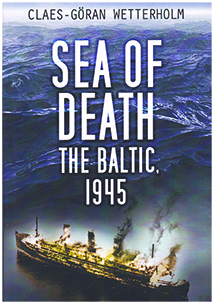Different perspective on the merchant marine in WW2
Sea of Death, by Claes-Gӧran Wetterholm
Image on landing page: Captain Friedrich Peterson of the Wilhelm Gustloff. Taken from Sea of Death
' Telegrapher Rudi Lange had given his life jacket to a woman with three children who had not been able to get hold of a single one … He thought of Goebbels' question in a speech just after the defeat at Stalingrad: "Do you want total war?" and the enthusiastic response it had brought. He and everyone else on the Wilhelm Gustloff were now in this total war, but no one was cheering now.' – Sea of Death, page 121
Telegrapher Rudi Lange had given his life jacket to a woman with three children who had not been able to get hold of a single one … He thought of Goebbels' question in a speech just after the defeat at Stalingrad: "Do you want total war?" and the enthusiastic response it had brought. He and everyone else on the Wilhelm Gustloff were now in this total war, but no one was cheering now.' – Sea of Death, page 121
This is the story of how 10,000 lives were lost in the Baltic Sea in the final days of the Second World War – including many civilians, and many on cruise ships and liners.
The Wilhelm Gustloff had been pressed into service to evacuate German townspeople from East Prussia as victorious Soviet forces swept in to take over land that is now part of Poland and Lithuania.
Unfortunately for the refugees, Soviet submarines were happy to treat the vessel as an enemy target, and as Claes-Goran Wetterholm explains, this was just one of many incidents in 1945 that saw the Baltic change from a sea that had been relatively quiet during the war to a mass grave full of WW2 shipwrecks.
Wetterholm has written and lectured extensively on the sinking of the Titanic and Lusitania, but with Sea of Death, he is seeking to draw attention to a series of less well-known maritime disasters that took place near his homeland of Sweden.
In the chaos of 1945, numerous merchant vessels and passenger ships were on the move at the instigation of the German government, carrying troops as well as refugees, and in the case of the Cap Arcona, removing concentration camp prisoners from the mainland. This former luxury liner was then bombed by the RAF, in what some believe should have been investigated as a British war crime.
The focus is on the harrowing events of 1945 in the Baltic, but the author also looks back at the origins of the vessels involved – with the Wilhelm Gustloff famously having been intended as a holiday ship for the German people. Other vessels had been requisitioned from the German merchant fleet or from occupied nations such as Norway.
Whatever the history of these ships, it's safe to say that there were a great many merchant seafarers onboard, and it is important that their story is told, just as we now recognise the contribution of their counterparts on the Allied side. Claes-Gran Wetterholm does a fine job of this, ably supported by the History Press in a well-presented volume with a good index and bibliography, plus photos and maps throughout. It's a sobering read, but an important one.
Sea of Death: the Baltic, 1945
By Claes-Goran Wetterholm (translated by Eric Kentley)
History Press, £20
ISBN 978 07509 95078
Buy this book in the Nautilus Bookshop
While you're there, why not browse the rest of the titles in our unique maritime bookshop, which sells all the books reviewed on these pages.
Buy nowMore Books
The history beneath our hulls
Shipwrecks of the Solent by Richard M JonesThis slim volume of maritime history is a fascinating book to have by your side when you're crossing the busy Solent sea area.
Bicentenary books about a beloved body
One Crew, by Helen Doe, and 200 Years of Lifesaving at Sea, by MirrorpixThe RNLI celebrated its 200th anniversary on 4 March this year. To mark the occasion, two attractive new books have been published: an official history and a 'life in pictures'.
Powerful academic appraisal of life at sea
Sea-Time: an ethnographic adventure, by Helen SampsonFew people have done more than Professor Helen Sampson to raise awareness and understanding of the lives of the world's seafarers.
Health reminder for maritime men
Sailing Through Life, by Nick ArdleyThis book is a helpful reminder to those working in the male-dominated seafaring industry that going for a checkup could save your life.
